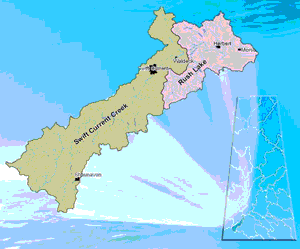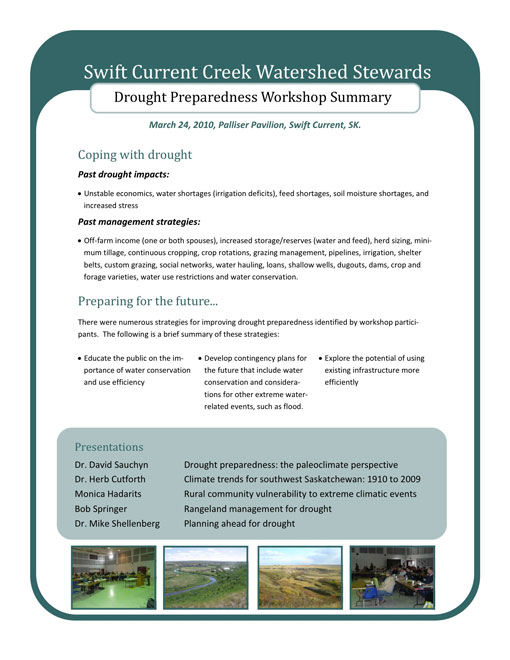Drought Preparedness
Success Story – Swift Current Creek Watershed Stewards
As Saskatchewan gets warmer and drier it is also expected to experience more severe and frequent extreme climate events, including floods and droughts. Part of the Saskatchewan Watershed Authority’s watershed management efforts has been to engage local residents in watershed planning. The Swift Current Creek Watershed Stewards are one group that has a completed plan (Figure 1).
The Swift Current Creek Watershed is located in the south-west portion of the province and includes the city of Swift Current. See Communities – Swift Current for information on climate change and its impacts (hyper link to communities page on SC)
Watershed Management Planning
The Swift Current Creek Watershed Management Protection Plan was completed in the Fall of 2009. One of the 62 key actions arising from the plan was to address the impact of climate variability on flow regimes.
Drought Preparedness Workshop
The Swift Current Creek Watershed Stewards are working towards addressing the issue of climate variability within the watershed. Their initial effort focused on drought and included a Drought Preparedness Workshop held on March 24th, 2010. The results of the workshop are summarized below (Figure 2 – Drought Preparedness Workshop Summary). Subsequent preparedness planning workshops were held in 2010/11 where the discussion included extremes in moisture as well as drought. The results are currently being compiled.
While this is an on-going initiative, there are several important drought-related adaptation observations:
- Addressing water-related climate change issues benefits from a watershed approach and involvement of local residents, provincial and national interests.
- The impact of drought on the agriculture community has been and will be significant.
- Response to drought has included both short term actions and long term adaptation. Short term actions include: off-farm income, water conservation and restrictions and water hauling while long term adaptations include: new infrastructure, dry land cultivation techniques, new crop varieties and conversion of marginal farmland from annual cropping to permanent pasture.
- Future adaptations include education (water conservation), planning and increased use efficiencies.
Additional information is available on the website for the Swift Current Creek Watershed Stewards and the website for the Stewards’ Watershed Protection Plan.
Sources:
- Swift Current Creek Watershed Advisory Committee (2009): Swift Current Creek Watershed Management Protection Plan.
- Pittman, J., Saskatchewan Watershed Authority (2011): Personal Communication relative to climate variability workshops in the Swift Current Creek Watershed Authority.

